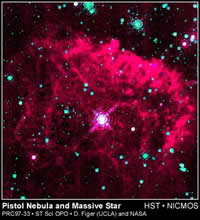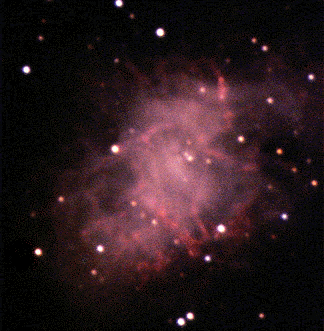The red giant star Betelgeuse: red giants are stars that have exhausted
their Hydrogen fuel and are burning Helium and heavier elements.
Click on image for full size
Image courtesy of NASA, Hubble Space Telescope Institute
Creating Elements up to Iron
When the temperature in the core of a star reaches 100 million degrees
Kelvin fusion
of Helium into Carbon occurs (three Helium nuclei combine to form a
nucleus of Carbon). In the same range of temperature Oxygen is also formed
from fusion of Carbon and Helium together.
At 500 million degrees Kelvin two Carbon (2 12C) nuclei
can fuse to form heavier elements such as Neon (20Ne+4He),
Sodium (23Na+1H), and Magnesium (24Mg).
Oxygen can start burning effectively at temperatures on the order of
1 billion degrees Kelvin. The fusion of two nuclei of Oxygen can produce Sulfur
(32S), and Silicon (28Si+4He).
The heaviest elements obtainable through a fusion process that releases
energy are obtained at a temperature range of 2 billions degrees Kelvin,
when two Silicon nuclei can fuse to form Nickel
(56Ni). Nickel-56 can then decay into Cobalt and Iron.
Movies courtesy of University of Oregon
You might also be interested in:

Atoms are composed of a massive, central nucleus surrounded by a swarm of fast-moving electrons. The nucleus is made up of protons and, in most cases, neutrons. Almost all of the mass (more than 99%) of
...more
Fusion in the core of the stars is achieved when the density and temperature arising from the gravitational pressure are high enough. There are different fusion cycles that occur in different phases of
...more
The basic Hydrogen fusion cycle involves four Hydrogen nuclei (protons) and two electrons and yields a Helium nucleus, two neutrinos and six photons. This process occurs in three steps: the first one is
...more
Neutron capture can occur when a neutron approaches a nucleus close enough for nuclear forces to be effective. The neutron is captured and forms a heavier isotope of the capturing element. When the new
...more
A Supernova is a very massive star that explodes at the end of its life cycle. The supernova is the furnace where the heavy elements (heavier than iron) are formed by neutron capture.
...more
IMF stands for Interplanetary Magnetic Field. It is another name for the Sun's magnetic field. The Sun's magnetic field is enormous and is carried by the solar wind. The solar wind and magnetic field are
...more
Nuclear fusion is a process where two or more nuclei combine to form an element with a higher atomic number (more protons in the nucleus). Fusion is the reverse process of nuclear fission. Fusion of light
...more
The theory of relativity states that no particle can travel at the speed of light in a vacuum. However, light travels at lower speeds in dense media, like water. A particle traveling in water must have
...more















